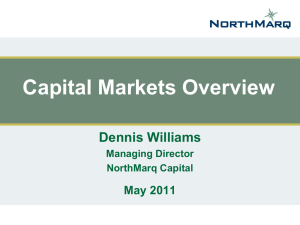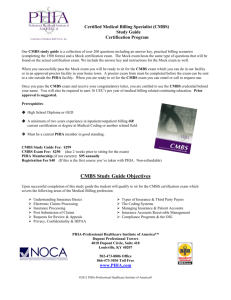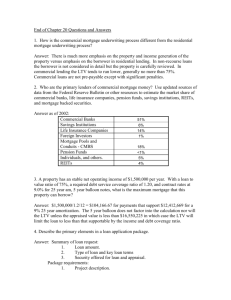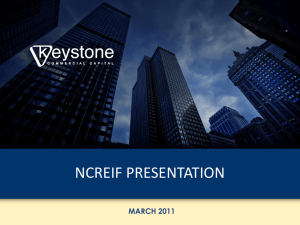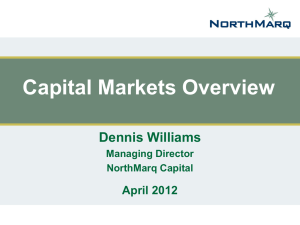The CMBS Market
advertisement
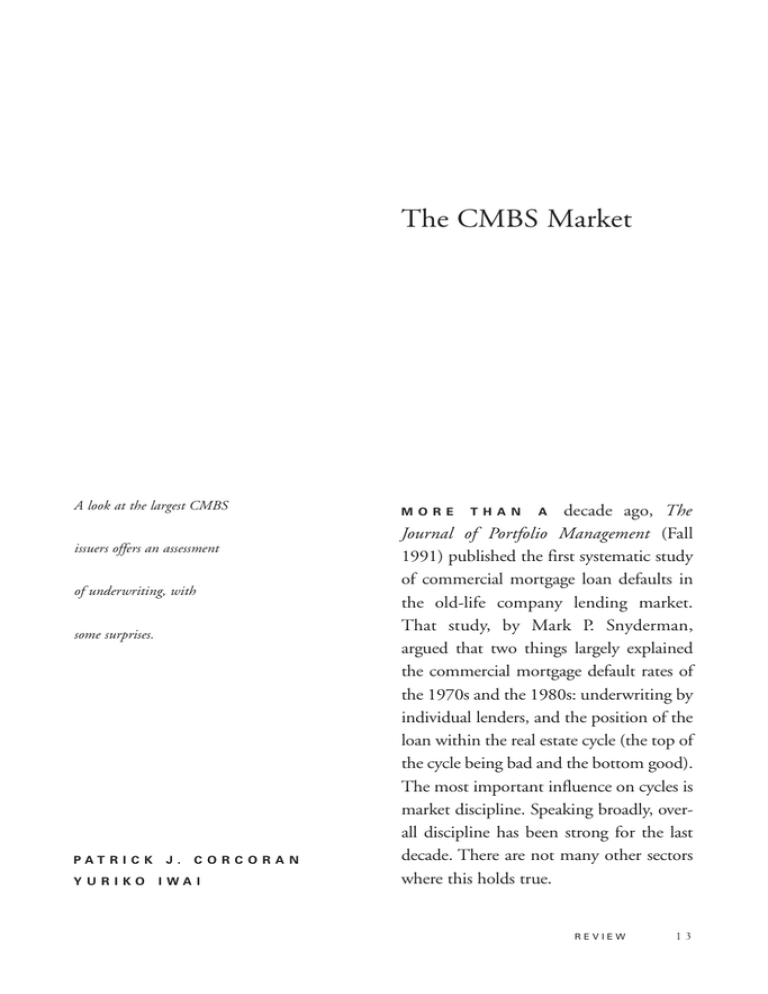
The CMBS Market A look at the largest CMBS issuers offers an assessment of underwriting, with some surprises. PAT R I C K YURIKO J. CORCORAN IWAI T H A N A decade ago, The Journal of Portfolio Management (Fall 1991) published the first systematic study of commercial mortgage loan defaults in the old-life company lending market. That study, by Mark P. Snyderman, argued that two things largely explained the commercial mortgage default rates of the 1970s and the 1980s: underwriting by individual lenders, and the position of the loan within the real estate cycle (the top of the cycle being bad and the bottom good). The most important influence on cycles is market discipline. Speaking broadly, overall discipline has been strong for the last decade. There are not many other sectors where this holds true. M O R E REVIEW 13 With spreads a lot tighter than previously, investors need to keep a sharp focus. There are a number of tools to assess CMBS value. The first relates to the language of credit performance itself—loan defaults, not delinquency. There have been very few material investment-grade bond defaults, as highlighted in Moody’s December 2003 study of structured product bond defaults (“Payment Defaults and Material Impairments of U.S. Structured Finance Securities: 1993–2002”). So, for the past two years, the focus has been on trailing loan defaults. The second tool is Credit Drift, a proprietary technique that J.P. Morgan Securities Inc. has been using since 1998. Credit Drift deals broadly with discipline, but it also deals with loan-level real estate issues. The third tool grows out of a study of loan underwriting performance. D E FAU LT S, NOT DELINQUENCY The best way to understand the CMBS credit story is to look at the trailing threemonth loan default measure in core loans (Figure 1). Core loans cover retail, apartment, office, and industrial loans, about 90 percent of loan collateral in 2002–2003 deals. The trailing default rate closely tracks the historical Fitch loan default rates. A difference is that the trailing rate is a dollar-weighted loan default measure, whereas the Fitch default rates are calculated as the number of loans that default. Prior to the 2001 recession, defaults were running at about a 50 bps annual rate. At the start of the recession, the default rate jumped to about 90 bps, and has remained there ever since. At the end of 2002, it Figure 1: Loan Default Measures Core Loan Delinquency Core Loan Default Rate 4.0% 2.0% 1.8% 3.5% Delinquency Rate 3.0% 1.4% 2.5% 1.2% 2.0% Pre-recession defaults at 50 bps 1.0% 0.8% 1.5% 0.6% 1.0% 0.4% 0.5% 0.2% 0.0% Jan-99 14 0.0% Jul-99 ZELL/LURIE Jan-00 REAL Jul-00 Jan-01 ESTATE Jul-01 CENTER Jan-02 Jul-02 Jan-03 Jul-03 Default Rate Recession defaults at 90 bps 1.6% looked like defaults might be dropping off, but they subsequently reverted to their recession pace of 90 bps. Suppose a pool of ten-year core CMBS loans posted three years of recession defaults at 90 bps per year and seven years of non-recession defaults of 50 bps per year, in line with a number of CMBS loan default models. The cumulative default rate is 620 bps. Using a 40 percent loss severity, the ten-year loan loss is 248 bps. This compares with an average credit enhancement level for BBB bonds in 2003-vintage CMBS deals of 620 bps. In this example there is ample protection for bonds rated BBB and higher to avoid losses. By contrast, in the 1980-1993 period, Baa/BBB corporate bonds experienced ten-year defaults of about 5 percent. With an average loss severity of 60 percent, tenyear cumulative losses add up to 300 bps. In contrast to the case of CMBS Baa/BBB bonds, 300 bps is an estimate of portfolio losses in corporate bonds. In CMBS, the credit enhancement acts as a shield, with the losses borne by lowest rated tranches, which are rated less than BBB. The trailing default measure has the advantage of transparently revealing the solid credit story in CMBS. By contrast, the conventional delinquency measure has continued to increase, seemingly pointing to weakening credit performance. Investors who focused on this measure missed the opportunity to overweight the sector in 2001-2002. The biggest problem with the delinquency measure, viewed as an index of CMBS credit conditions, is its long lag. Basically, it is a collection of credit problems extending back several years, rather than a measure of recent credit problems. Even worse than the conventional delinquency measure is the so-called enhanced delinquency measure, which adds to delinquent loans the actual losses realized in the quarter through the sale of foreclosed properties. The enhanced delinquency measure compounds the problem of the information lag by providing additional focus on the oldest credit problems in the delinquency bucket. Investors who follow such indicators are unlikely to get the correct credit story and make the proper allocation to CMBS. Strong credit in 2001-2003 coincided with property values that generally fell less rapidly than property cash flows. This resulted in declining gross yields on property, or cap rates, in the 2001-2003 episode. The property markets are saying that property cash flow declines are temporary, and largely related to the recession. We believe that the commercial real estate sector remains reasonably disciplined. This contrasts with the overbuilding boom and property price bubble of the 1980s and early 1990s. Firming property prices in 2001-2003 have been very important in keeping borrower equity cushions intact and in minimizing CMBS REVIEW 15 loan defaults. This recent episode contrasts with the early 1990s, when property prices fell more sharply than cash flows due to rising cap rates (Figure 2). Property markets overall remain reasonably disciplined. However, there are two yellow flags. Property price firmness may be overdone, and we would underweight the apartment sector. We are also cautious about larger trophy transactions, which have been such a large part of 2003 large loans and have often been featured in the top-ten loan lists in conduit/fusion deals. Investors should insist on shadowratings in these large trophy transactions in order to ensure large loan underwriting reasonably consistent with historical practice in the CMBS market. LOAN D E FAU LT AND LOSS SEVERITY TRENDS Table I shows a default model that groups retail, office, apartment, and industrial loans into a category we call core CMBS loans. These loans account for about 90 percent of 2002-2003 loan collateral, and perhaps 85 percent of all loans in earlier vintage years. Default frequency is very low in the first two years of the loan’s life, rising to a maximum in the five-to-six-year range, and subsequently is slightly lower. Estimated recession default probabilities are approximately double non-recession default frequencies. This model explains loan defaults for different vintage and calendar years, with the recession default fre- Figure 2: Cap Rates 9.5% Undisciplined Markets 9.0% Disciplined Markets 8.5% 8.0% 7.5% 7.0% 19 78 19 79 19 80 19 81 19 82 19 83 19 84 19 85 19 86 19 87 19 88 19 89 19 90 19 91 19 92 19 93 19 94 19 95 19 96 19 97 19 98 19 99 20 00 20 01 20 02 6.5% 16 ZELL/LURIE REAL ESTATE CENTER Table I: Core loan default model with recession Default Assumptions: Non-Recession Scenario Toddler Default Rate Recession Scenario 0.221% WAL Toddler Default Rate 0.434% 0.4x 0.67x Adolescent Default Rate 0.370% Adolescent Default Rate 0.727% 3 to 4 years Adult Default Rate 0.552% Adult Default Rate 1.086% 5 to 6 years 1.0x Senior Default Rate 0.370% Senior Default Rate 0.727% 7 years or more 0.67x Year of Default 1995 1996 1997 1998 1999 2000 2002 2001 Vintage Year Weight 2 years or less 2000 1999 6 1998 8 16 24 32 8 4 14 24 42 79 37 12 39 39 96 104 8 6 12 20 39 58 136 101 -35 4 8 14 14 41 41 123 114 -9 2 5 8 8 12 23 15 72 67 -5 1997 1996 2001 2002 4 Summary Estimated Actual Core Core Total Total Error 4 0 -4 1995 1 2 3 3 5 5 7 10 37 35 -2 1994 0 1 1 1 1 1 1 1 7 5 -2 1993 0 0 1 1 0 0 1 1 5 1 -4 Estimated Core Total 2 6 14 27 46 67 173 209 544 1 -1 6 0 7 -7 34 7 36 -10 66 -1 171 -2 218 9 539 -5 Actual Core Total Error -5 539 0 0 5 Sources: FitchRatings, JPMorgan quencies employed in the years 2001 and 2002. Using Fitch calendar year total defaults and vintage year totals suggests that the model provides a good fit. The differences between estimated and actual defaults in the different vintage years represent estimates of “vintage effects.” The three top-of-the-cycle years—1999 through 2001—have defaults that substantially exceeded projections. This is in line with studies of the old life company market, which found the top-of-the-cycle to be a location with above-average loan defaults. Also, note the large swing between strongly favorable vintage effects in 1998 and strongly unfavorable vintage effects in 2000. This corresponds to the retrenchment in real estate lending in 1998, driven by the downturn in global securities markets, followed by a return to more normal lending markets in 1999 and 2000. While 1998 is the year with the most favorable vintage effects, it is also has the largest concentration of hotel and health care loans. By contrast, 2002 and 2003 vintage deals have negligible amounts of REVIEW 17 these riskier loans. In general, the CMBS market today is pricing bonds in solidly performing seasoned deals at significantly tighter spreads than new issue bonds, adjusting for differences in dollar bond price. However, we believe that 20032004 vintage CMBS deals will ultimately have favorable bottom-of-the-cycle vintage characteristics, relative to deals of 20012002 and 2005–2006. Studies of the private commercial mortgage market in the 1970s and 1980s indicated an average loss severity of approximately 36 percent, a lower 30 percent to 35 percent range in the 1970s, and a higher 40 percent to 45 percent range in the overbuilt 1980s. Table II shows loss severity estimates for CMBS loan defaults as of the end of 2002. The CMBS weighted-average loss severity encompass not merely foreclosures, but also discounted payoffs and loan modifications—as well as a substantial number of loans that quickly became current with zero loss. In addition, most CMBS defaults and losses were realized in a relatively short interval, in 2000 to 2002. The CMBS loss severity estimates have struck some investors as being on the high side, or at least with a tail of the distribution tilted to the high side. However, the period of 2000 to 2002 is short, and the data more plentiful than in the past. The overall loss severity is close to the 35 percent area that one would expect for secured mortgages (whether commercial or residential) on better quality property with conventional leverage levels. This range is of course much lower than the 60 percent area that is the long-run average loss severity for (mostly unsecured) corporate bond defaults. E V O LV I N G BOND SPREADS A year ago, we were bullish on CMBS spreads, the CMBS credit curve, and the CMBS credit story, advocating overweighting the sector. Today, with much Table II: CMBS Loan Loss Severity by Property Type (As of Dec. 31, 2002) Property Type Share Share of Total Defaults Share of Total Loss Weighted Loss Severity Multifamily 26.4% 14.0% 9.8% 30.6% Retail 29.0% 28.0% 48.4% 46.6% Office 20.6% 6.7% 2.3% 22.0% Industrial 6.8% 4.5% 2.8% 36.2% Hotel 8.8% 29.4% 29.3% 46.0% Health Care 2.5% 13.7% 6.2% 40.8% Other 5.9% 3.8% 1.2% 10.8% Avg Loss Severity - Core property types 33.8% Avg Loss Severity - All property types 33.3% Source: FitchRatings 18 ZELL/LURIE REAL ESTATE CENTER Figure 3: 10yr AAA CMBS Spreads 10yr AAA CMBS to Treasuries 10yr AAA CMBS to Swaps Spread to Treasuries (bps) 80 150 70 60 125 50 100 40 30 75 Spread to Swaps (bps) 90 175 20 50 1993 100 10 1994 1995 1996 1997 1998 1999 2000 2001 2002 2003 2004 Source: JPMorgan tighter spreads and an historically flat credit curve, the solid credit story remains intact. At the end of 2003, with spreads in ten-year AAAs at swaps plus 30 to 31 bps, this is the tightest margin to swaps since early 1998. At that time, the CMBS market did not even formally price higherrated bonds with reference to swaps, comparing CMBS only to Treasury. However, at that time, the market believed that corporate bond credit risk was minimal, and that CMBS were much riskier than corporate bonds. In hindsight, both of these views were incorrect. What has been driving CMBS spreads tighter the last three years has been the slow, but growing, awareness of how good the CMBS credit story is (Figure 3). There is an enhanced role for CMBS as a substitute for high-quality liquid assets such as swaps and Agencies, as well as a hedge for credit instruments such as corporate bonds. In a world with heightened and pervasive risks touching virtually every sector, the safety features of CMBS cannot be underestimated. In 2001 and 2002, CMBS posted the strongest total returns of any bond class in Lehman’s aggregate bond index. In 2003, CMBS returns were eclipsed by stronger corporate bond returns and narrowing corporate spreads. As a result, since midyear 2003, CMBS spreads have widened to corporate bond spreads (see Table III) at precisely the moment the market is beginning to appreciate the CMBS credit story. We expect that spread differentials between CMBS and corporate bonds will tighten. Table III suggests that in June 2003, BBB CMBS/corporate spread differentials had shifted downward, whereas REVIEW 19 Table III: CMBS vs. Corporates Spread Pickup Old Range 2000 - 1/2002 (bps) AAA/AA BBB/BBB AAA/A New Range 7/2002 - 6/2003 6/20/03 Latest 1/9/04 Industrials 16 to 56 19 to 43 25 20 Banks -37 to 23 -11 to 24 17 4 Industrials 17 to 62 -85 to 16 16 34 Banks -40 to 211 -80 to 4 -15 5 Industrials -65 to -92 -59 to -18 -30 1 Banks -73 to 5 -38 to 2 0 1 1 August 2000 through January 2002 2 November 2000 through January 2002 Source: JPMorgan differentials between AAA CMBS spreads and AA/A corporate spreads had not. However, today’s spread differentials are squarely back in the 2000 to January 2002 trading range, indicating little shift in CMBS/corporate spread differentials since early 2000. The view that CMBS credit and the underlying property markets remain disciplined rests on a ten-year track record of stellar credit performance and strong current readings in our quantitative Credit Drift methodology. Suppose, however, one believes that stocks and corporate bonds exhibit parallel discipline (relative to property markets/CMBS). Even then, this judgment must be tempered by the substantial uncertainty due to very limited data following the 2000 to 2002 meltdown in stocks. The widening of CMBS spreads relative to corporate bonds is also evident when comparing BBB CMBS spreads to those of the 20 largest REITs. The REIT 20 ZELL/LURIE REAL ESTATE CENTER bonds are unsecured, with leverage ratios for REITs typically around 50 percent, a mark lower than the 70 percent to 80 percent loan-to-value ratios typical for CMBS conduit loans. The relative attractiveness of unsecured REIT debt relative to BBB CMBS is a perennial debate among investors. It appears that REIT debt tends to outperform BBB CMBS when corporate bond spreads are rallying, while in corporate spread sell-offs, the reverse holds. UNDERWRITING: THE THE BAD, AND THE GOOD, U G LY The recent Fitch CMBS loan default study provides a basis for evaluating the performance of CMBS underwriters. By comparing each loan to a proper benchmark, it is possible to identify the impact of different underwriters on CMBS loan performance. To do this, a retail loan in 1997 is compared only to other retail loans originated in 1997. Fitch provides the number of defaults posted up to end-2002 of retail loans by vintage, and the same vintage benchmarks for retail, office, industrial, apartment, hotel, and health care loans, as well as other categories such as self storage, mixed use, etc. This means that CMBS underwriters can be compared to benchmarks in the same way that stock managers are evaluated. And, of course, they cannot all be the best. Strong market environments tend to minimize differences in results for different lenders. The true returns to underwriting are most evident when market discipline erodes! Table IV displays results for the ten largest underwriters arranged by issuer shelf. The top ten Fitch-rated issuers represent roughly $116 billion out of $156 billion of pre-2002 issuance. One reason for focusing on the top group is that there is sufficient issuance and a long enough track record to place some confidence in the results. On the left side of the table are the number of projected loan defaults based on the property type and origination. A positive percentage error means that the underwriting contribution was positive, with the actual defaults less than the benchmark. For all the Fitch deals, the projected number of loan defaults is very close to the actual because the benchmarks are basically the market. Assessing the underwriting contribution by number of defaults, there are six underwriters that under-performed the market benchmark, and four that exceeded it. Default frequencies by vintage and Table IV: Underwriting: Top 10 Issuer Defaults Shelf* CSFB/DLJ Estimated # of Defaults Actual Issuance (Wtd by # # of (ex- 2002) Loans) Defaults Error $25,598,486,273 125 123 1% JPMCC/CCMSC $17,846,592,310 97 84 14% GMACC $14,741,355,397 63 70 (12%) Estimated Defaults $776,129,353 Actual Defaults $747,323,828 Error 4% $513,743,032 $423,068,123 18% $469,799,194 $581,875,970 (24%) ASC/NASC/CMAT $13,771,878,694 50 63 (26%) $818,327,393 $711,381,864 13% MSC/MSDWC $12,408,459,553 66 39 41% $400,509,522 $174,114,522 57% 31% LB/UBS $8,859,681,811 32 28 14% $218,567,406 $150,778,356 MLMI/CMAC $8,387,107,597 68 87 (29%) $306,374,209 $511,245,987 (67%) SBM7/MCF $6,730,601,366 52 59 (14%) $227,958,613 $284,183,898 (25%) FULB/FULBA/FUNB/FUNC $5,998,060,509 34 52 (54%) $187,825,455 $189,980,125 (1%) GSMS $4,957,418,020 15 22 (48%) $197,684,779 $121,438,631 39% $ 155,963,903,200 762 777 (2%) $5,016,090,226 $4,598,797,599 8% Total *The shelves under which deals are issued are associated with the following underwriters: CSFB/DLJ= Credit Suisse First Boston, JPMCC/CCMSC= JPMorgan, GMACC=GMAC Commercial, ASC/NASC/CMAT=Nomura Securities, MSC/MSDWC= Morgan Stanley, LB/UBS=Lehman Brothers/UBS, MLMI/CMAC=Merrill Lynch, SBM7/MCF= Salomon Smith Barney, Sources: JPMorgan, FitchRatings FULB/FULBA/FUNB/FUNC=Wachovia, and GSMS=Goldman Sachs. REVIEW 21 property type are used to calculate a dollarweighted default benchmark. For the entire market, the dollar-default benchmark exceeds total dollar-defaults by 8 percent. By comparison, the projected number of total defaulted loans is below the actual by 2 percent. This difference indicates that large-loan default frequency is lower. The dollar-weighted underwriting contribution, or percentage error, is negative for four of the underwriters and positive for six. The underwriting contribution based on the number of loans overstates the impact of small-loan underwriting, since all loans are equally weighted in this calculation. Put differently, the measure is highly reflective of small-loan underwriting. On the other hand, the dollar-weighted underwriting measure is more reflective of largeFigure 4: Credit Drift Track Record Credit Drift Track Record 2003 Year-end Credit Drift 1998 Credit Drift 1.2% 6 1.0% 5 0.8% 4 0.6% 3 2 0.4% 1 0.2% 0 0.0% Apartment Retail Office Sources: JPMorgan, FitchRatings 22 1993-2000 CMBS defaults Cumulative Default Rates (%) Avg Credit Drift Scores 7 loan underwriting. Overall, there are four underwriters that outperform their benchmarks for both measures. There are two underwriters (ASC/NASC/CMAT and GSMS) that have negative underwriting contributions by number of loans, but positive underwriting by the dollar-weighted measure. In both of these cases, about two-thirds of their respective issuance are large-loan deals. A higher-than-average large-loan share also appears to be playing a role in the strong dollar-weighted underwriting contribution for LBUBS. In summary, this analysis provides a beginning in measuring the contributions of underwriters. While large loans come out favorably with implied lower default frequency, we think it is important that ZELL/LURIE REAL ESTATE CENTER Industrial Figure 5: Credit Drift Components 105 Index Rental Market Indicators RC/Value Index 110 FAVORABLE (above 100) 100 UNFAVORABLE (below 100) 95 investors insist on shadow-rating for most large loans. Historically, as in the early Nomura mega-deals, structuring in largeloan deals provided pooled credit enhancement to protect investment-grade bonds. With the proliferation of A/B notes and rake-like structures, that is less true today. R E C O M M E N DAT I O N S Since 1998, J.P. Morgan Securities Inc. has published Credit Drift scores for about 50 metro areas and seven major property types. As shown in Figure 4, the early 1998 scores anticipated both the low overall level of loan defaults and the relatively strong performance of office loans. Credit Drift uses both long-term and short-term 03 20 20 02 01 00 20 20 19 99 98 97 19 19 19 96 95 19 19 94 93 19 19 92 91 19 19 90 89 88 19 19 19 19 86 87 90 forecasts of property cash flows. The linchpin of the longer-term outlook is a measure of property value to replacement cost. The favorable direction means property valuations are depressed. The scores are roughly calibrated to allow for different degrees of leverage. The value-to-replacement cost measure was extremely unfavorable in the late 1980s (reflecting lofty property valuations) and was a forward indicator of falling cash flows. Similarly, depressed valuations in the early and mid1990s were a forward favorable indicator of rising cash flows. A continuing disciplined reading is observed in 2001-2003 in the long-run metric (Figure 5). Our judgment that market discipline is largely intact in commercial real estate derives primarily from the updated end- REVIEW 23 2003 Credit Drift scores. By property type, these scores remain in the middle of the 1 to 9 range. A score between 4 and 6 denotes equilibrium, or stable cash flows. A score in the 7 to 9 range corresponds to falling cash flows, while a score from 1 to 3 signifies rising property cash flows. The mid-range scores are also close to the 1998 retail and apartment averages, which were followed by generally solid credit performance in these loan categories. Since the third quarter, Credit Drift apartment scores have slipped further, to an average of 6.6. In our view, this warrants caution about this sector generally. We would make up the apartment sector underweight by modestly overweighting retail, office, and industrial loans. The problem with apartment loans stems largely from a combination of weak leasing markets and increasing property prices. For other property types, 2001-2002 witnessed sharp declines in property cash flows, accompanied by smaller declines in property prices. NCREIF cap rates suggest that apartment cap rates have dropped to slightly above 6 percent, while cap rates for other property types are hovering around 8 percent. Moreover, if one looks at NCREIF apartment properties in the third quarter of 2003 with updated thirdquarter appraisals, the average apartment cap rate is even lower. Similarly, the impact of discipline on declining construction starts is evident in office properties, indus- 24 ZELL/LURIE REAL ESTATE CENTER trial warehouse, and, to a lesser extent, retail properties. However, there is no evidence of a slowdown in apartment starts. A final area of concern is the large trophy property transactions coming into CMBS deals in the top-ten loan list. 2003 has seen a large flurry of such loans, and the recent cheapness of new issue bonds relative to seasoned paper has been concentrated around the lumpier new issue deals. Large trophy properties whose loans are included in top-ten lists typically feature strong long-term leases. By contrast, it is considerably less common to see larger loans with broken leases because the market is nervous. We are concerned that a number of recent bidding contests reflect overpricing of trophy properties. The difference in value of two similar properties, one with long-term and the other with short-term leases, is the present value of a rather short-dated cash flow stream. Investors ought to pursue shadow-rating for these large loans in CMBS deals. Historically, large loans have been made to fairly stringent underwriting terms, roughly comparable to shadow-rating today. That is the primary reason that large loans have to date displayed lower historical default frequency than conduit loans.
